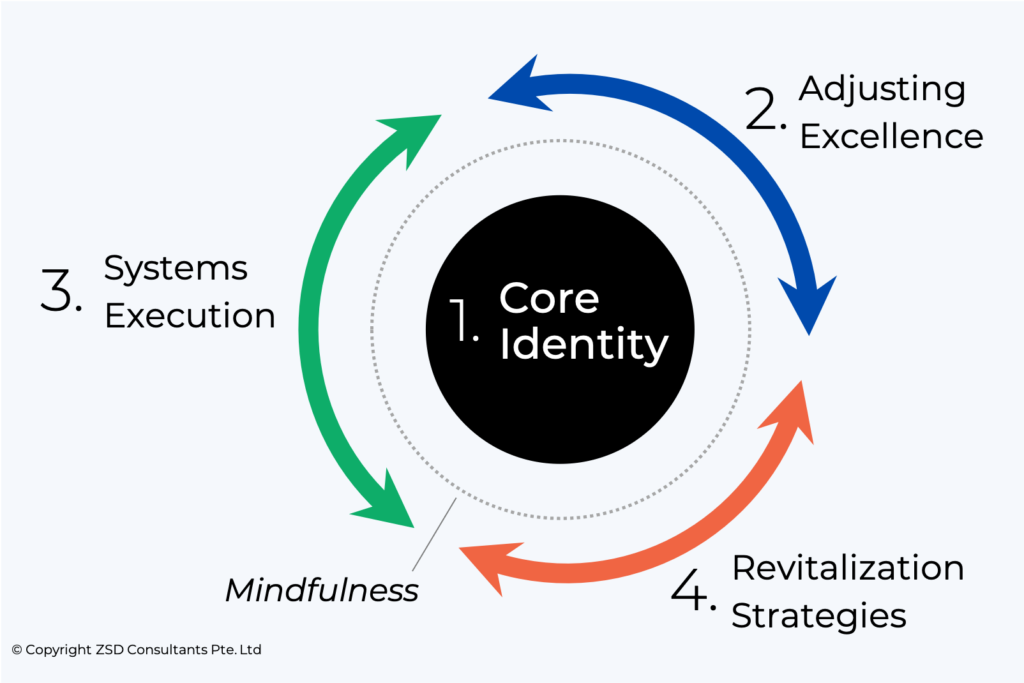Quick Recap
Welcome to the second article in this opening series introducing ADIO Chiropractic Coaching.
In the last article, I introduced the operating system of ADIO Chiropractic Coaching’s methodology. We discussed how this operating system is the back bone of a successful professional life in Chiropractic. It’s an article you do not want to miss; here’s the link if you want to read it.
Here is the model again for your reference.
The Four Pillars of Sustained Success In Practice

The Four Pillar model above is my answer to the following question:
What does it take to be successful in Chiropractic practice and what is required to sustain success over the long-term?
The Four Pillars are all about helping Chiropractors build and sustain thriving practices that make profound impacts in the world.
In the last article, Part One, we introduced the First Pillar: Your Core Identity in practice. We discussed why this first pillar is the crucial central hub that drives your success in practice. We also briefly touched on how clarity and certainty of your Core Identity will help you excel in the other three pillars. Functioning at high levels in all Four Pillars is the pathway to sustained excellence in your professional life.
In this article, we will build on Part One as we zero in on the Second Pillar: Adjusting and Clinical Excellence. This article is primarily an introduction to foundational concepts within the ADIO Chiropractic Coaching system. I utilize these concepts with much more depth and breadth throughout the coaching process with my clients. Let’s dive in.
Pillar Two: Your Adjusting and Clinical Excellence
Unfortunately, too many practice management outfits give, at best, fleeting lip-service to the importance of adjusting and clinical skills in practice building. In contrast, ADIO Chiropractic Coaching holds great reverence for the immense power of the Chiropractic adjustment.
Your Adjusting Skills are Crucial to Your Success
I want to state this fact unequivocally: your ability to deliver the goods with your hands is a critically important factor in your success in practice. You need to be an excellent adjuster, full stop.
This not only means knowing how to adjust, but also determining when not to adjust, and how to properly calibrate your application of force when appropriate. Chiropractors should be experts in spinal biomechanics, patient positioning, force application, and energy flow. They should have near wizard-like tactile abilities. Great Chiropractors are artists with their hands.
If, in Chiropractic college, you were the type of student that shied away from practicing adjusting and attending extra adjusting seminars, you may probably be behind your colleagues in the field. If you put your sole focus on getting the best possible grades and passing your boards, while ignoring developing your adjusting skills—thinking you would become proficient in adjusting at some undefined point in the future—you may have a steep hill to climb to make up the ground you’ve lost. If this describes you, it is past time for you to get to work in this area.
Becoming a great adjuster requires significant time on task. The only way to get good at something is to do it over, and over, and over again. The often-repeated maxim that “Repetition is the mother of all skill,” is absolutely true.
Put the work in to continually improve your ability to adjust a wide variety of body-types, subluxation patterns, and to address specific clinical situations. Reach out to mentors and colleagues if you have clinical questions or for specific case management advice. Don’t stop adding tools to your tool belt to help more people in your practice.
Being a Skilled Adjuster Grows Your Practice
Being able to provide an extraordinary adjusting experience for your patients is clearly important for achieving great clinical outcomes, but it is also crucial for the nuts and bolts of practice building. Masterful adjusters automatically attract more referrals and they retain patients at higher rates.
Your Adjusting Skills Boost Your Marketing
One of the most effective marketing tactics you could ever employ is being a great adjuster. It’s pretty obvious, but patients are much more likely to refer people to a practice that they like going to. Patients need to feel honored, respected, and cared for while being adjusted. If they value your presence, your connection, your intention, and your commitment to being in the moment with them during their adjustments, then they will be much more likely to sing your praise to the people in their lives. They also need to trust that your clinical decision-making is driven by their best interest, not yours. Your actions and non-verbal communications speak volumes in the realm of trust building and rapport.
Chiropractors that consistently see a large number of internal referrals are usually the ones that have put in the most effort to reach their potential as adjusters.
Your Adjusting Skills Impact Your Retention
Do the quality of your adjustments cause your patients to come back again and again? Do your patients look forward to being adjusted by you? How would they describe the experience of being adjusted by you? The answers to these questions affect the stability of your practice.
Your Retention outcomes are impacted by your adjusting and clinical skills. If your patients feel improvement through your adjustments, they are much more likely to follow your recommendations and graduate into the next stage of care. They are much more likely to happily re-sign if they feel your adjustments are exceptional. Work diligently to elevate your skills as an adjuster and separate yourself from the run-of-mill Chiropractors in your community. Your Retention will improve as a result.
Is Your Technique Breaking You Down?
Have you thought about how your adjusting technique is impacting your own body? Is the way you are bending, moving, interacting with your patients causing damaging trauma to your body? Are you physically sore after a busy adjusting shift? Are you at risk for a repetitive strain injury? An injury to your low back, shoulder, wrist etc. can snuff out a promising career. How long a Chiropractor stays in practice is often directly affected by the quality of biomechanics the Chiropractor utilizes while adjusting.
Commit to extreme care when it comes to your posture and positioning while you are working at your adjusting tables. The correct doctor positioning while adjusting can make your adjustments more smooth and more effortless. Attention in this area can safeguard you from a physical injury. Make this a non-negotiable habit.
Do not neglect yourself when you are adjusting. Too many careers have been lost to injury.
Can You Physically Handle Doubling Your Practice?
If you are reading this article, you likely want to make a greater impact through your practice. I would bet that the bottom line is that you want to adjust more people. You’re looking for growth.
Can you physically handle adjusting double the number of patients that you see right now? I’m not talking about your marketing or your schedule or your conversion process, etc. I‘m talking about you. Can you physically take doubling your practice? Are you in the right kind of physical condition to vastly increase the number of patients you currently see? Will your current approach to adjusting allow you to thrive in practice over the next 20 years?
If you do not resoundingly say “Yes!” to these questions, then you’ll likely encounter friction as you work to grow you practice.
Take a look at the following areas:
- Your fitness and physical conditioning
- Your technique
Commit to improving your fitness and your physical conditioning as your practice grows. Make sure your core muscles are strong. Work to retain good flexibility in your spine and peripheral joints. Focus on your posture as well. If you need to lose weight, get to work. Your level of health and vitality will affect your growth trajectory in your practice.
Analyze all aspects of your body mechanics when you are adjusting. Go through a self-audit. You may need to simplify your technique or alter your movement patterns when working patients. Make sure your joints are in correct alignment as you thrust and eliminate excessive bending at the waist. Keep your abs and inner unit muscles tight when you carry out dynamic movements. Avoid putting your shoulders, elbows, and wrists in compromising positions while adjusting.
You probably already know what to do in this area. Don’t get sloppy with your conditioning or your technique. Have the discipline to follow your own advice to prevent injuries. Let’s remain colleagues far into the future.
Adjusting Skills Alone Are Not Enough
Two things can be true at the same time. It is crucial that you are great adjuster, but having excellent adjusting skills alone won’t guarantee that you will have a thriving practice.
In order to build a busy, profitable, and sustainable practice, it is absolutely necessary that you are an effective adjuster. There’s no avoiding that fact. It is required. But having proficient manual skills alone is not sufficient. You also need to develop the organizational, communication, and leadership skills to build the infrastructure of your practice operations. You need to build a practice, not just an adjusting center.
Do you want to be a mere ‘spinal technician’ or a ‘manual therapist’? Are you interested in learning how to effectively lead your patients to optimally benefit from their care over the long-term? To follow your recommendations and stay with you? Do you envision building a retention-driven practice that is built-to-last? Of course you do. This is what I want for you as well.
Commit to Walking the Path of Mastery
For the committed Chiropractor, walking the path of mastery as an adjuster is a lifelong journey. Your adjusting abilities will expand and evolve as you gain more experience. As your influence expands through your practice, your confidence will grow as well. You can accelerate this growth with sustained attention to your craft. The Second Pillar: Your Adjusting and Clinical Excellence must always retain a prominent role in your professional life.
Continue to seek out adjusting mentors and attend technique seminars. Stay curious in this area. The art of Chiropractic was likely an important inspiration for you in joining this great profession. Always work to elevate the importance of the Chiropractic adjustment through your practice. Never cheapen its power. Your practice exists to help the people you serve through your adjustments. Never lose sight of this simple fact.
In this article, we have established that your adjusting skills are crucial to your success in practice, and that you should sharpen these skills on a regular basis. But you also need to develop the Third Pillar: Your Systems, Procedures, and Operations, to lead your patients to adopt Chiropractic as a lifestyle—so they can benefit from your extraordinary adjustments throughout their lives.
We’ll dive into this critical topic in the next article in this series.
Stay tuned!
-DZ




